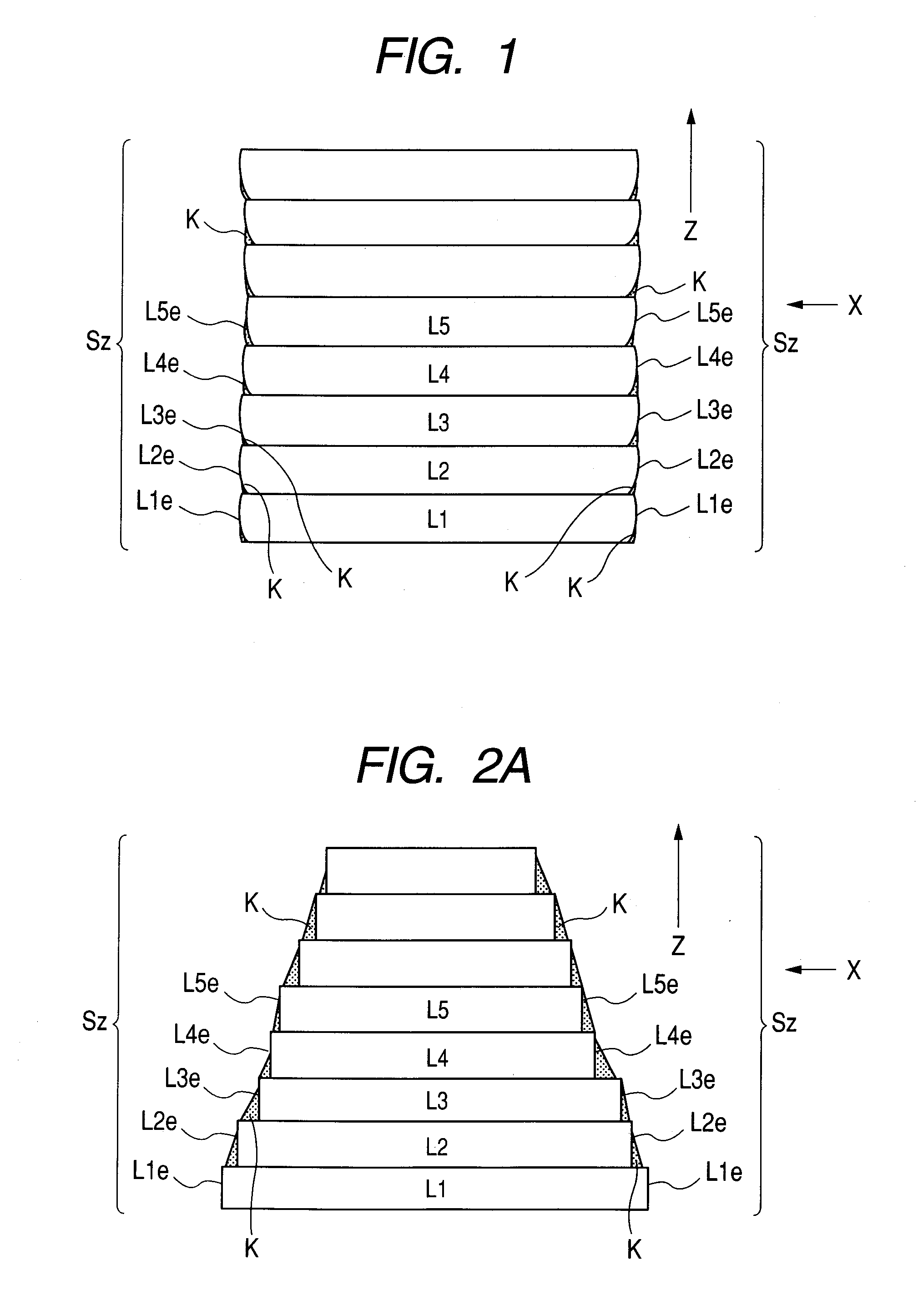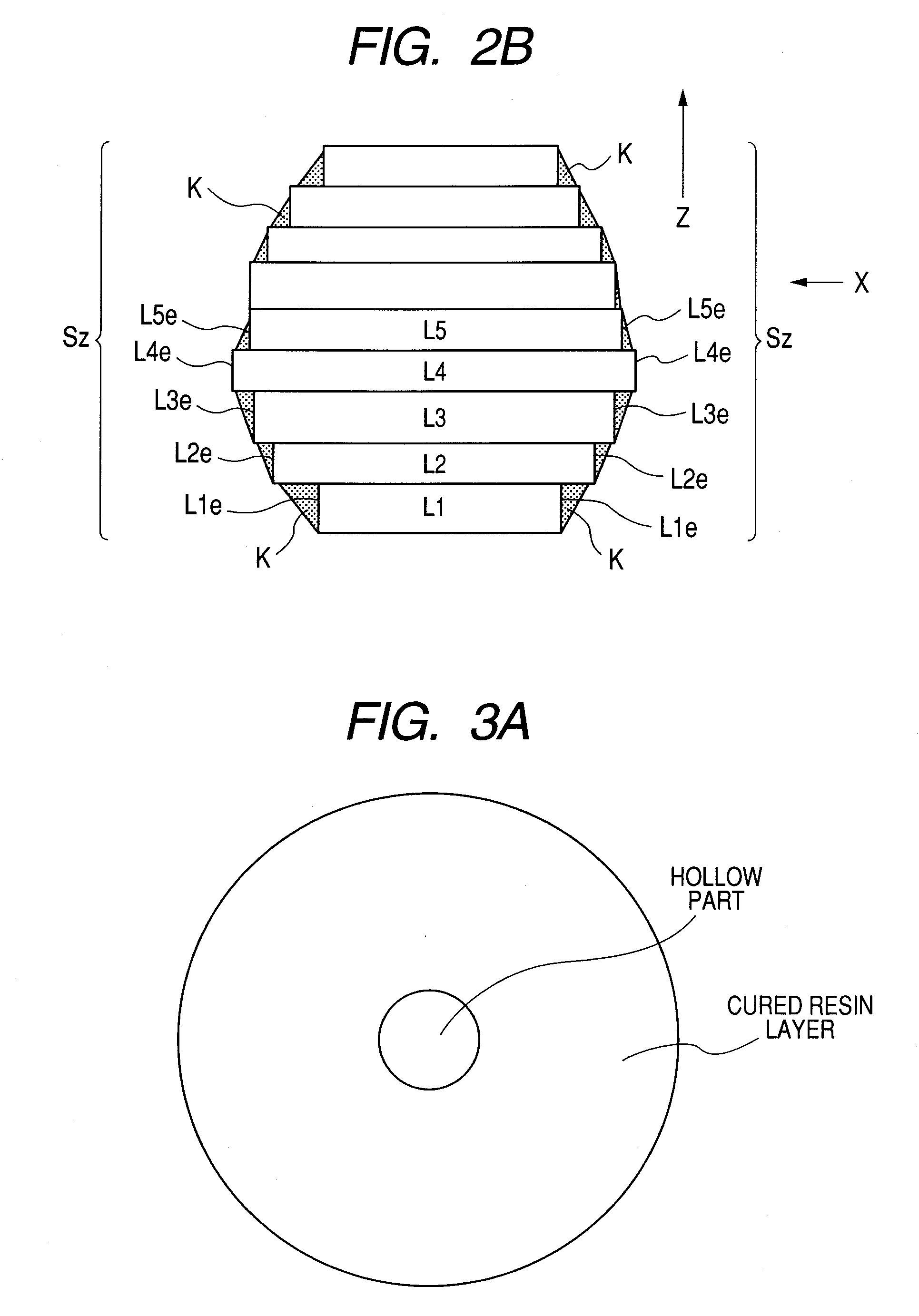Three-Dimensional Object Having Smoothed Fabricated Edge Surface
- Summary
- Abstract
- Description
- Claims
- Application Information
AI Technical Summary
Benefits of technology
Problems solved by technology
Method used
Image
Examples
example 1
[0160](1) 60 parts of hydrogenated bisphenol A diglycidyl ether, 20 parts of 3-hydroxymethyl-3-ethyloxetane, 4 parts of bis-[4-(diphenylsulfonio)phenyl] sulfide bishexafluoroantimonate (cationic polymerization initiator), 10 parts of dipentaerythritol polyacrylate (“NK Ester A-9530” manufactured by Shin-Nakamura Chemical Co., Ltd.), 3 parts of 1-hydroxy-cyclohexylphenylketone (radical polymerization initiator), and 6 parts of laurylacrylate were mixed to prepare a photocurable resin composition, and the photocurable resin composition was accommodated in a tank shielding light.
[0161](2) By using The photocurable resin composition obtained in the above (1), a three-dimensional object (10 mm×10 mm×40 mm) shaped like a square column as shown in FIG. 1 was manufactured with an ultra-speed stereolithography system (“SOLIFORM500B” manufactured by TeijinSeiki Co., Ltd.) in which stereolithography was performed to perpendicularly irradiate the surface with “Semiconductor-excited solid laser ...
examples 2 to 5
[0170](1) Components in Table 1 were mixed at a ratio shown in Table 1 to prepare a photocurable resin composition and the photocurable resin composition was accommodated in a tank.
[0171](2) An optical three-dimensional molding was performed by using the photocurable resin composition obtained in the above (1) with the same method as the (2) of Example 1, and a three-dimensional object (10 mm×10 mm×40 mm) which is shaped like a square column as in FIG. 1 was manufactured.
[0172](3) With respect to the three-dimensional object obtained in the above (2), a surface roughness Ra of the fabricated edge and a transparency (transmittance of visible light) in a direction perpendicular to the fabricated edge were measured with the foregoing method, and the result was as shown in Table 1. The segregation of the fabricated edge of the three-dimensional object was tested by the foregoing method, and the result was as shown in Table 1.
TABLE 1Example 2Example 3Example 4Example 5(Photocurable resin...
examples 6 to 9
[0173](1) Components in Table 2 were mixed at a ratio shown in Table 2 to prepare a photocurable resin composition and the photocurable resin composition was accommodated in a tank.
[0174](2) An optical three-dimensional molding was performed by using the photocurable resin composition obtained in the above (1) with the same method as the (2) of Example 1, and a three-dimensional object (10 mm×10 mm×40 mm) which is shaped like a square column as in FIG. 1 was manufactured.
[0175](3) With respect to the three-dimensional object obtained in the above (2), a surface roughness Ra of the fabricated edge and a transparency (transmittance of visible light) in a direction perpendicular to the fabricated edge were measured with the foregoing method, and the result was as shown in Table 2. The segregation of the fabricated edge of the three-dimensional object was tested by the foregoing method, and the result was as shown in Table 2.
TABLE 2Example 6Example 7Example 8Example 9(Photocurable resin...
PUM
| Property | Measurement | Unit |
|---|---|---|
| Content | aaaaa | aaaaa |
| Surface roughness | aaaaa | aaaaa |
Abstract
Description
Claims
Application Information
 Login to View More
Login to View More - R&D
- Intellectual Property
- Life Sciences
- Materials
- Tech Scout
- Unparalleled Data Quality
- Higher Quality Content
- 60% Fewer Hallucinations
Browse by: Latest US Patents, China's latest patents, Technical Efficacy Thesaurus, Application Domain, Technology Topic, Popular Technical Reports.
© 2025 PatSnap. All rights reserved.Legal|Privacy policy|Modern Slavery Act Transparency Statement|Sitemap|About US| Contact US: help@patsnap.com



